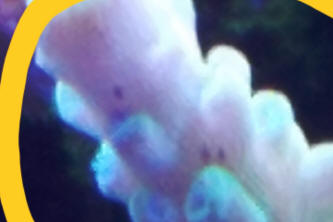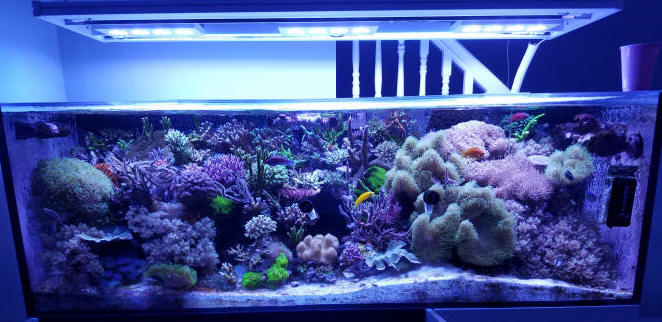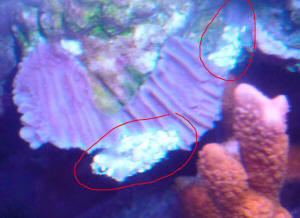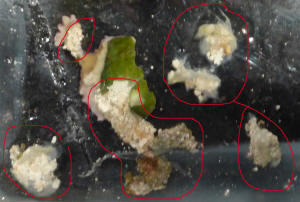|
FAQs about Acroporid Coral Pathogenic Disease
FAQs on Acroporid Disease:
Acroporid Disease 1, Acroporid Disease 2, Acroporid Disease 3, Acroporid Disease/Pests/Predators
4, Acroporid Health
5, Acroporid Health
6, Acroporid Health
7, Acroporid Hlth.
8, Acroporid
Hlth. 9, Acroporid Hlth. 10,
FAQs on Acroporid Disease by Category:
Diagnosing,
Environmental (Pollution/Poisoning, Lighting...),
Nutritional, Social (Allelopathy),
Trauma,
Predatory/Pest
(see below), Treatments
FAQs on Pests of Acroporids:
Montipora Munching Nudibranchs,
Flatworms,
Red/Black "Bugs"
Acropora Munching Copepods,
Related Articles: Coral Pests and Disease; pests, predators,
diseases and conditions by Sara Mavinkurve, Acroporids, SPS
Corals,
FAQs on Stony Coral Disease by Type: Brown Jelly Disease, RTN,
|
|
|
Acro Spots
6/12/19
Bob,
<Eric>
Do these look like red or black bugs on my Staghorn?
<Mmm; no; don't see any "legs".... Bob Fenner>
Thanks,
Eric
|
 cropped
cropped |
|
Re: Acro Spots
6/12/19
Any idea what they could be? Haven't added anything new. Also haven't seen any
damage on the coral but this is one that gives me almost no polyp extension,
even at night.
<Maybe... algae colonies. Scrape some off and look at under a low power 'scope
mate. BobF>
Re: Acro Spots
6/12/19
Any tips on how to get some polyp extension on this stag?
<Oh, yes; the usual: "good water quality", adequate N, P, K... likely the
supplementation of iron and zinc... Using ORP/RedOx as a measure of system
viability...>
I do have a few other colonies that are not doing great. I attributed it to my
light upgrade a few months back even though they haven't recovered. I have a
feeling the right side of my tank is the problem.
<Borrow a PAR, PUR meter and check>
Whether it's the flow that is being blocked or some type of allelopathy.
<See/read on WWM re my overall comments re... the use of ozone/O3 mostly...
perhaps punctuated use of chemical filtrants (activated carbon/Chemipure,
PolyFilter)... Bob Fenner>
Re: Acro Spots
6/12/19
Sorry Bob, forgot to include.
<Wow! Some Cnidarians now! BobF>
|
 |
|
Reef Tank: Need an ID weird tube structure
8/29/2009
Hey guys I keep getting this tube like formation around my
Montiporas.
It has a consistency of super glue, mixed with sand. I tear it
apart in hopes of catching something inside but to no avail. Any
chance you guys know what it is and how to catch it?
<I suspect this is a type of tumour caused by pathogenic
bacteria...>
It's annoying, it eats/erodes the side of the Montipora it
attaches to build its tube structure.
Also the structure is built on the live rock. I attached some
photos to see if you can ID it.
Thanks,
Mark
<Please read here:
http://www.coremoc.go.jp/english/pub/coralreefjapan/0203_coral_diseases.pdf
Bob Fenner>
|
  |
"Bubble" on My Acropora - 10/20/06 Hi.
<<Hello>> I have a very quick question I hope you can help
me with. <<I shall try>> I have an Acropora coral that has
a bubble type appendage toward it's base where it appears it was
snapped off from the mother colony. The bubble is not brown
(dreaded jelly disease) and looks healthy with extended small polyps
extending off the bubble. I have had the coral for at least
5-6 months now. The coral is growing well and other then the
bubble in question is in perfect health with very good color and polyp
extension mostly at night with a little during the day. I
have no idea what this bubble is and I can't find anything on
it. All my other Acros are doing great. If I am
naive and this is the start of some kind of infection I want to get on
it before it gets out of hand. <<I doubt this is an
"infection," these usually act quite fast and you would heave
noticed some deleterious effect by now. I suspect what you
have is a "parasite"...despite how that sounds, in this
instance these are usually symbiotic or at least commensal
relationships and thus benign. Some crustaceans are known to
take up residence on the skeleton/in the flesh of Acropora
corals. The most common that I have witnessed are small
barnacle looking crustaceans and very small crabs...the latter is
visibly active (feeding) from a small opening in the corals flesh, the
latter is usually completely encased in a lump or goiter of the corals
flesh. To my knowledge and in my experience, neither do
permanent harm or prevent the coral from growing/flourishing>> For the record my water parameters are: 0 nitrate 0 Ammonia
0 Nitrite 0 Phosphate Alk 11 (stable) Calcium 380 SG 1.025, Temp 80 PH
8.3 (stable with reverse light cycle on refugium) The coral has a nice,
healthy strong random flow over it. No linear current or
anything. The coral is housed under (2) 150watt HQI metal
halide and 260watts of mixed PC 10k and actinic and is in the top 1/4
of the tank. I have attached a picture however it is not
very good quality. The best I can do with my meager
equipment. <<I'm afraid we didn't get the picture>>
I was hoping you could provide some insight on the matter. <<I
don't think you need be concerned. Any
"treatment" of the coral is likely to do more harm than
good>> Thank you very much you are always a great help. Regards,
John Weglarz <<Happy to assist. Eric
Russell>>
"Bubble" on My Acropora - II - 10/21/06 Hello
again. <<Hello John>> Thank you for the reply Eric.
<<My pleasure>> I believe your diagnosis is dead accurate.
<<I do get lucky sometimes <grin> >> I have not seen
any parasites/crabs though they may be to small for me to see with the
naked eye, or perhaps I am not looking close enough or at the right
time. For the record when the goiter does burst there is
perfectly healthy flesh underneath and it seems this phenomena started
when the Acropora began growing rapidly. <<Hmm, curious...but if
the coral does not seem to be suffering any deleterious effects from
this I would leave it be>> As you stated and I have witnessed
there is no harm done, it just struck me as being odd and I was
concerned it may be the start of something detrimental.
<<Understood>> I did a lot of research on the matter and I
couldn't find any information on this topic. I believe
your explanation on this matter will be instrumental in putting other
reef keepers concerns at ease should they encounter this phenomenon.
<<Or at least encourage them to research/observe before taking a
hasty course of action that can often be more harm than good>>
Thank you ever so much. Regards John Weglarz <<Always happy to
help, Eric Russell>>
|
|

